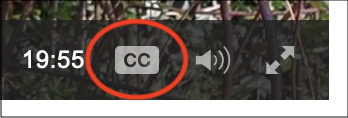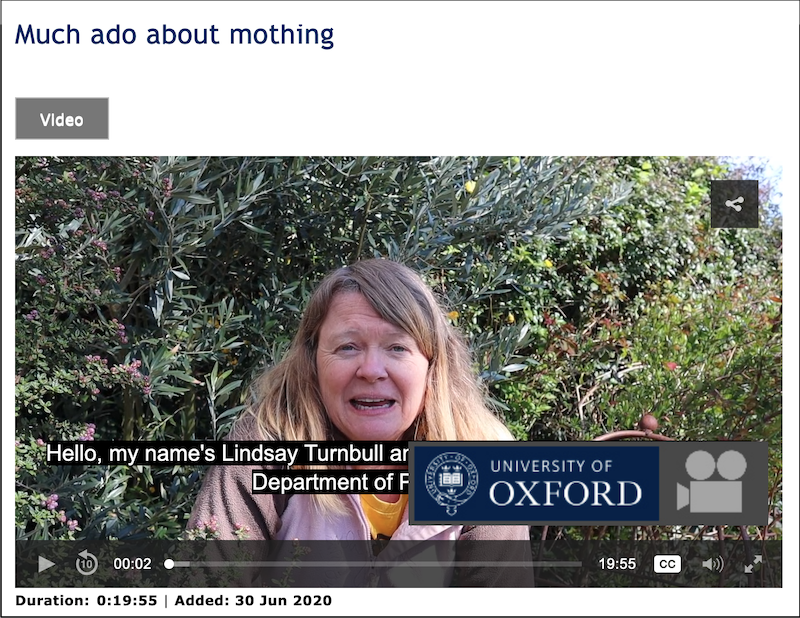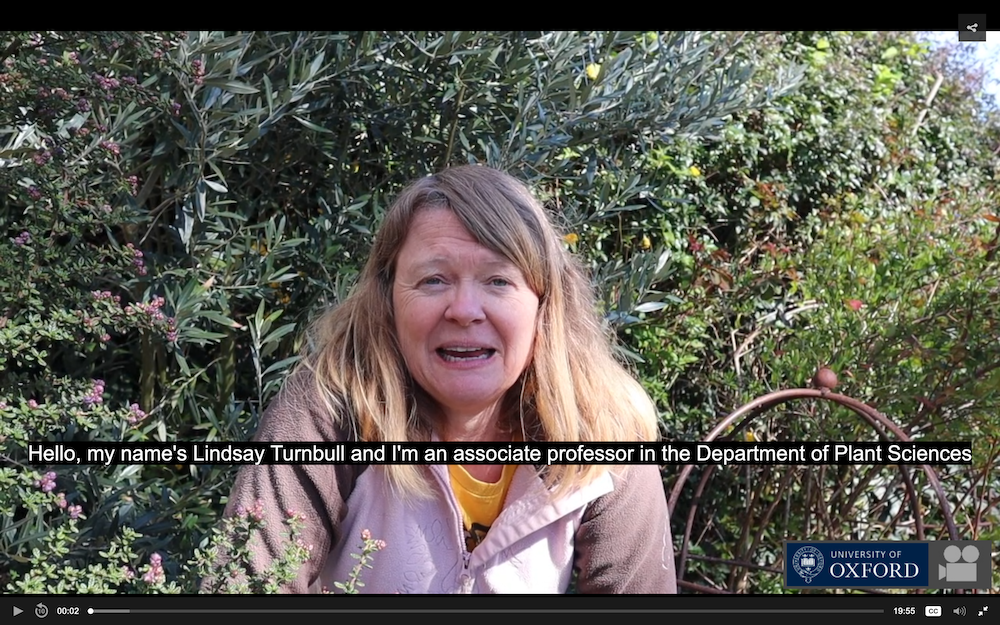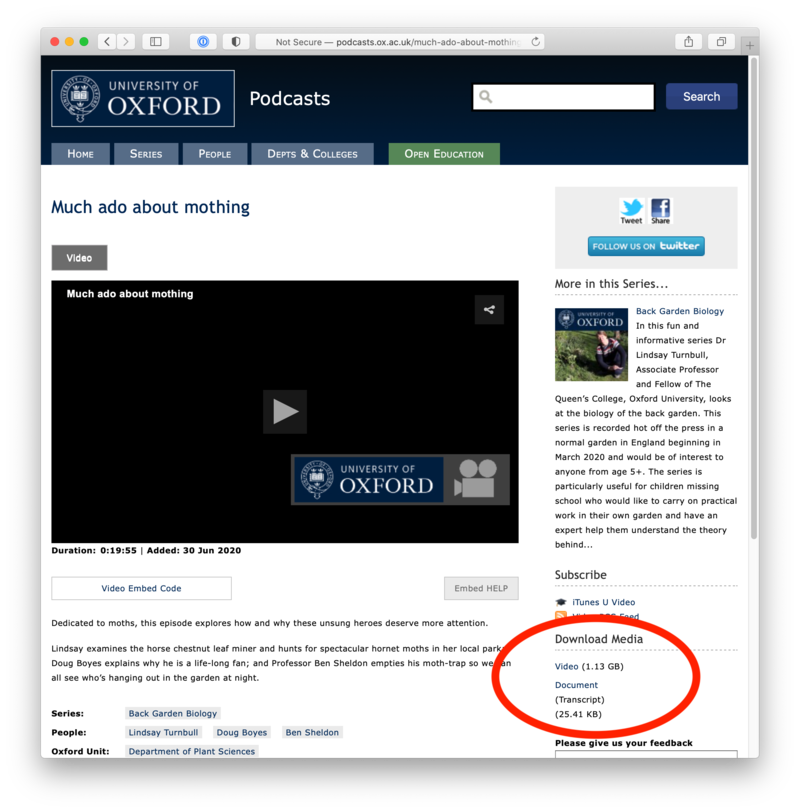Podcast accessibility, and captions/transcripts on the University Podcasts site
Information on podcast accessibility issues, and the accessibility features of podcasts.ox.ac.uk including Closed Captions (CC) and transcripts
Oxford podcasting and accessibility
There are over 800 podcast series published by the University of Oxford across a range of subjects, and we are committed to make these as accessible as possible to all audiences. We will do this by providing additional support such as transcripts and captions for podcasts, and making our website as usable as possible.
New accessibility regulations for public sector websites became legal requirements from September 2020, namely the W3C Web Content Accessibility Guidelines (WCAG) 2.1. Educational Media Services are moving towards compliance with these as quickly as possible, and will then proceed to expand our accessibility commitment.
Who is this page for?
This page is split into two sections. The tab 'For podcast listeners / viewers' outlines current accessibility features for Oxford podcasts and how to get additional support. The tab 'For podcasts producers' gives advice on making podcasts as accessible as possible, including generating captions/transcripts.
Help for podcast listeners / viewers
1. Improve accessibility using browser and device settings
There are customisation options for your browser and device that could help you use our sites and other websites more effectively.
AbilityNet provide advice on making your device easier to use if you have a disability.
2. How to use accessibility features on our sites (video captions and audio transcripts)
We publish University of Oxford podcasts to two places:
From 23rd September 2020, all new video and audio content on the University of Oxford Podcasts site (http://podcasts.ox.ac.uk) should have captions available. We aim to generate the captions before publishing, however the WCAG regulations allow 14 days from the publishing date.
Captions can either be viewed as part of the video, or downloaded as a transcript text file.
2a. Viewing Closed Captions on a video podcast
To view captions on a video podcast episode, click the 'CC' button in the bottom-right corner of the media player:


The University logo will unfortunately obscure the captions, as shown below:

You can either wait for the logo to disappear or make the video player full-screen using the maximise button bottom-right:

In the full-screen view the University logo does not obscure the text:

We intend to move the University logo in the near future.
The CC button will only appear if a captions file has been generated.
Captions will display slightly differently on different web browsers, you may wish to experiment. We will make the captions downloadable as text files in the immediate future. We are exploring how improve the media player (JWplayer) functionality, e.g. to provide synchronised transcripts/captions for audio files.
There is a list of captioned podcast episodes on the University of Oxford Podcasts website. We will be providing a list of captioned series in the immediate future.
The Apple Podcasts service does not provide any specific accessibility guidance.
2b. Downloading Closed Captions as a transcript text file
The captions for a podcasts episode reside in a text file in 'SRT' format. This essentially means it contains every line of dialogue, with a timestamp against each line to say when it should appear alongside the video.
If a podcast episode on University of Oxford Podcasts website (podcasts.ox.ac.uk) has Closed Captions, these should be downloadable from the 'Download Media' section of the page (bottom-right). Look for the 'Document' link:

Left-click the 'Document' link to view the captions file in your browser. You may wish to open it in a separate tab or window:

To save the Closed Captions file to your computer, right-click the 'Document' link and choose 'Save File' or similar. You should then be able to open the resulting '.srt' file in a text editor like Notepad (Windows) or TextEdit (Mac).
3. Where our service is limited in regards accessibility
The University of Oxford Podcasts website (podcasts.ox.ac.uk) has various limitations regards accessibility:
- Title/heading structures, links and image alt-text are not consistent for screen readers
- Tab/keyboard navigation around the site is inconsistent
- Colour contrast cannot be altered
- Screen magnification is untested
- Captions/transcripts are available for only a small selection of podcast series before 23rd September 2020
- Captions/transcripts are computer-generated and this limits their accuracy
- Audio transcripts are not yet downloadable (this will be fixed very soon)
There will be more detail in the revised accessibility statement for University of Oxford Podcasts once completed.
The MediaPub publishing portal has similar limitations.
4. Who to contact for help
For further assistance using the University of Oxford Podcasts site please email the Educational Media Team at University of Oxford IT Services.
Guidance for podcast producers
Podcast producers are advised to also read the tab 'For podcast viewers / listeners' to understand the accessibility features available on University of Oxford Podcasts (podcasts.ox.ac.uk), especially Closed Captions (CC).
Why make your podcast accessible?
As noted above, the European WCAG 2.1 regulations require all audio and video content ("time-based media") published to the web to be supported by text equivalents. This means audio podcasts require a transcript and video podcasts require Closed Captions.
If you host your podcasts within a self-managed public webpage or website, the regulations also require this be accessible.
The WCAG regulations are most obviously there to ensure web content is available for less able users, but many of the considerations for this group of people have positive effects on usability for everyone. Here is a useful webpage about why to make your podcast accessible.
Defining Closed Captions, transcripts and subtitles
In the context of accessibility, the above have distinct meanings.
Closed Captions, also known as CC, are intended for those with limited hearing to improve comprehension of video content. Unlike subtitles, captions are in the language the video has been produced in. Captions may include information about non-verbal cues, such as music playing and noises off-screen. Captions are usually stored in a text-only file which consists of lines of dialog and the timing information for when to display each one. "Closed" captions mean the text can be shown or hidden as preferred, while "open" captions are always displayed ("burned in").
Transcripts contain the dialog from the media, often with notes on who is speaking if there are multiple presenters. They are usually provided in PDF or text-only format. They do not normally contain timing information.
Subtitles are primarily for hearing users who do not understand the original language of a video and require a translation while they are viewing it (e.g. "foreign language" films).
Generating Closed Captions and/or a transcript for a podcast
Generating Closed Captions for a video using Panopto:
IMPORTANT: A captions file is required for each video podcast episode published to the University Podcasts site.
University of Oxford staff and students can generate captions for free using Panopto, the lecture capture software. Once a video is uploaded to your personal Panopto folder, captions should be generated automatically. You can then edit them for accuracy and download the captions file. It will be a text-only file ending in 'srt'.
The captions file can then be used alongside your video on the University Podcasts site, or other video file repositories such as YouTube.
Below are the basic steps for generating captions for a series for publication on University of Oxford Podcasts (podcasts.ox.ac.uk). Some knowledge is presumed. See the Replay support page on generating captions for more details including a video guide.
- Log into Canvas then access your My Panopto folder
- Create a new sub-folder for your series content, e.g. 'Philosophy For Today'
- Upload the podcast media files
- Wait for automatic captions to be generated
- Correct minor mistakes using Panopto's built-in captions editor
- Download the captions file for each episode, renaming it to match the name of the episode
- Email the captions files to Educational Media and we will upload them into the MediaPub podcast publishing system
Please email Educational Media Services for assistance with publishing captions.
Transcribing audio using Microsoft Word Online:
IMPORTANT: A transcript is required for each audio podcast episode published to the University Podcasts site.
University of Oxford staff and students with access to Nexus/Office 365 can use Microsoft Word Online to generate a transcript from an audio file. It will try to identify different speakers, you can edit the transcript for accuracy, and choose whether to include timing information. Users are limited to 300 minutes transcription (5 hours) per month. See this Microsoft support page on using Word Online to transcribe your audio file.
This feature is not available in the installed (desktop app) version of Microsoft Word.
Tips for improving accessibility when creating an audio/video recording
When recording a teaching session, please consider the following points, which will ensure the recording is an effective resource for students. This guide was produced in collaboration with the University of Oxford Disability Advisory Service.
Audio
- If using a fixed microphone, be sure to stay within range of the microphone when speaking. If it is necessary to turn away (for example to write on the board) stop speaking and resume when facing the microphone again.
- A wireless lapel microphone is better for accommodating board work and/or moving around the lecture theatre. Place the lapel microphone approximately 15-20 cm below your chin and ensure a clear path to the microphone (e.g. no scarves covering the mic).
- In large spaces echo can be a problem. To overcome it don’t stand too close to the sound system speakers.
- Speak clearly at a normal, steady pace
- Describe visual information
- Repeat questions from the audience before answering as the original questions might not be audible in the recording.
- Describe visual information containing core learning material. This is especially important for audio-only recordings but will help people with visual impairments in all cases. Mention slide numbers during the lecture (i.e. "Here on slide 6...") to make it easier to follow any accompanying slides on audio-only recordings.
Video
-
Face towards the audience and the camera whenever possible, especially for important points. Looking at the camera will make the experience more engaging for students.
-
Stay within the camera frame.
-
Adjust the lighting to remove glare from overhead lights.
-
Maximise the visibility of handwritten notes and drawings and be conscious of size and readability. Is the text readable from camera distance? On a whiteboard use fully inked markers in high contrast colours such as black or dark blue. On a blackboard press firmly so chalk leaves a solid white image
-
Consider using a dedicated camera for capturing your whiteboard/chalkboard text and images clearly.
-
Consider the background and the image that will appear on the screen. Complex patterns or high contrast colours on walls, furniture and even clothing might cause clarity issues for the camera. Muted, solid colours work most effectively.
Get support
For help with podcasting and publishing contact Educational Media Services
Local IT support provide your first line of on-the-spot help
Contact us
Educational Media Services
13 Banbury Rd, Oxford, OX2 6NN
Tel: (+44) 01865 289983
Email: media@it.ox.ac.uk



